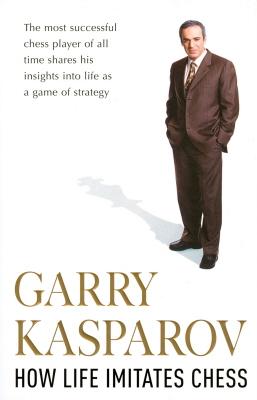
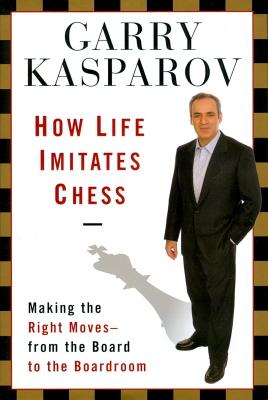
Edward Winter
(2008)
Stéphane Pilawski (Liège, Belgium) writes:
‘An interesting (and sometimes frustrating) aspect of chess books lies in the differences that may be found from one publisher to another or from one edition to another (even from the same publisher). A case in point is the recent book by Garry Kasparov, How Life Imitates Chess. I bought, and enjoyed, the French edition, La vie est une partie d’échecs (Paris, 2007), and later noted that two English-language versions exist, from Heinemann, London and Bloomsbury, New York.
After reading the Bloomsbury edition, I remembered that some ideas and stories that I had seen in the French edition were simply missing, so I took a closer look at both books and found that entire passages had been left out from one edition to the other.
Specifically, at the end of each chapter in the French edition Kasparov gave a few anecdotes, highlights, quotations and characteristics regarding the chessplayers he had mentioned in the chapter or about other people whom he admires. That material does not exist in the Bloomsbury edition.’
Of the two English-language editions (hereafter referred to as ‘Heinemann’ and ‘Bloomsbury’ respectively), only the former has the (rather perfunctory) material to which our correspondent refers. Overall, the Bloomsbury edition seems breezier, tighter and more accurate, yet it is the longer Heinemann volume that lacks an index. If different publishers in different countries demand different content, there is little an author can do about it, but the textual variations, however large or small, mean that anyone quoting from the book has a choice of editions and needs to avoid confusion and the suspicion of misquotation.
The principal weakness of How Life Imitates Chess relates to its own use of quotes, and in the present item we plan to concentrate on that aspect in some detail. As intimated above, quotes are particularly numerous in Heinemann, with sets of four on some pages.
The heading to chapter 5 of Heinemann on page 53 (page 48, chapter 4 in the case of Bloomsbury) professes to cite Capablanca: ‘I see only one move ahead, but it is always the correct one.’ No source is given, of course, because none is known (see, for instance, the discussion in C.N. 4483), and that of itself should have resulted in the quote being expunged. Are there not enough authenticated chess observations to choose from?


Heinemann and Bloomsbury
An example of an outright error comes on page 151 of Heinemann (with an almost identical wording on page 119 of Bloomsbury):
‘The Austrian Rudolf Spielmann wrote that we must “play the opening like a book, the middlegame like a magician, and the endgame like a machine”.’
C.N. 4156 showed that this remark pre-dates Spielmann:
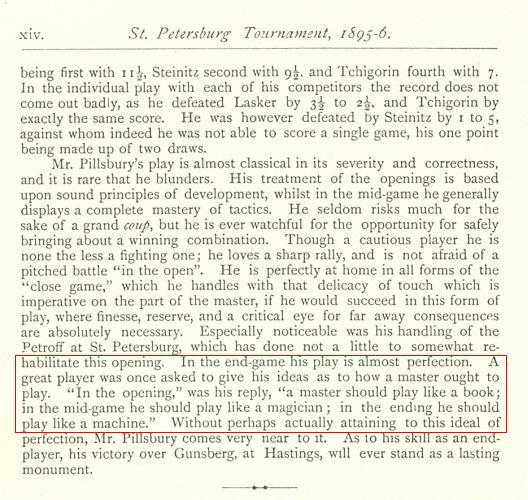
The Games in the St Petersburg Tournament 1895-96 by J. Mason and W.H.K. Pollock (Leeds, 1896)
Or again, from page 171 of Heinemann:
‘A concept related to the initiative was elucidated elegantly by Aarton [sic] Nimzowitsch, who wrote that “the threat is stronger than the execution”.’
On page 125 of Bloomsbury the master is fortunately mentioned only by his surname, but both editions disregard the fact that the saying was already known in the nineteenth century (from both Eisenbach and Mason). See A Nimzowitsch Story.
Kasparov’s output is naturally not alone in such defective handling of other people’s remarks (far from it), but in a high-profile book he could have been expected to give a lead. If the Heinemann edition cannot even run to an index, that publisher is unlikely to want an appendix with sources or, perish the thought, footnotes specifying the provenance of quotes. But why not cite only what is known to be genuine? Inaccurate quotation sits particularly poorly in a book about self-awareness and self-improvement written by an author in whom the misquotation defect has been pointed out, on and off, for over two decades. Such negligence drags everything down, yet, with a little research, the offending cases in How Life Imitates Chess (or, at least, Bloomsbury, which has far fewer unattributed quotes than does Heinemann) could have been largely rectified within the time required for a single book-signing expedition.
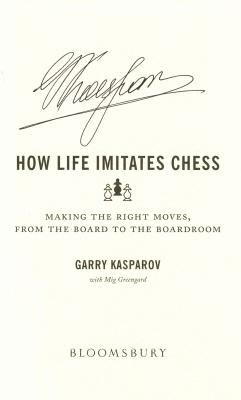
Turning again to the textual differences between the two editions, we note a minor one on a major issue. It will be recalled that Kasparov has several times condemned, with hindsight, his decision to break away from FIDE. He does so once more in this book, and both editions state:
‘This turned out to be a terrible blunder, the worst of my career.’ (Heinemann, page 115; Bloomsbury, page 107.)
There is, though, a slight difference in the introductory comment. From page 114 of Heinemann:
‘In 1993 I committed the fatal mistake of launching an attack from a position of weakness.’
On page 106 of Bloomsbury ‘fatal’ becomes ‘dreadful’. For what purpose?
In contrast, a truly significant divergence between the two editions relates to another Kasparovian peccavi. On pages 184-185 of Heinemann he accepts that he was justifiably criticized for volume one in his Predecessors series, thereby gratifyingly pulling the rug from under those unqualified commentators who pronounced it a masterpiece. (It somehow even received the British Chess Federation’s ‘book of the year award’ in 2003.) Kasparov’s entire confession is, unfortunately, absent from Bloomsbury.
Of course, such mea/nostra culpa admissions by Kasparov have been seen before, and notably concerning the defects of his autobiography Child of Change (London, 1987). Initially, that book too was lauded by nescient toadies, but the wind departed from their sails when Kasparov conceded, ‘I deserved the critical reception of Child of Change’ and ‘I was too light-hearted, I did it just in between, which was very bad’. He promised that an amended edition (Unlimited Challenge) would be better, but that hardly proved the case. So when now (on page 184 of Heinemann, but nowhere in Bloomsbury) Kasparov admits to, inter alia, ‘editorial haste’ regarding the first Predecessors volume (particularly in the analysis), it is a welcome avowal, but one to be treated with caution. The real test should come later this year with his book on ‘Kasparov v Karpov 1975-1985’. To what extent will it contain a belated amende honorable for his brash (to use no stronger adjective) misstatements in the 1980s on the Termination?
The present item has focussed on the weakest aspects of How Life Imitates Chess, but we are by no means blind to the book’s qualities. It is, for the most part, well written and bright, and the Heinemann and Bloomsbury volumes both have, in their different ways, plenty to commend them. What is really required now, however, is a third edition, with more editorial rigour.
(5375)

Regarding the Termination of the 1984-85 world championship match, the new book ‘Garry Kasparov on Modern Chess Part Two Kasparov vs Karpov 1975-1985 including the 1st and 2nd matches’ (London, 2008) required Kasparov to choose (irrespective of the overall conclusions he wished to present) between two approaches:
It is Option B all the way.
(5765)
The heading to Chapter 4 in the London, 2007 edition of How Life Imitates Chess (page 41):
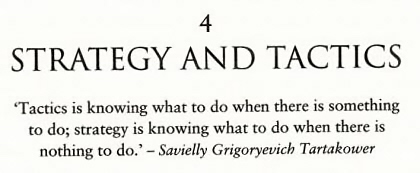
In the US edition (New York, 2007) this ‘Tartakower quote’ is in the heading to Chapter 3, on page 36. But did Tartakower make such a remark and, if so, where and when?
The earliest citation that we can currently offer is nothing better than a ‘once’ reference in an article about Fischer by Harold C. Schonberg on page SM63 of the New York Times, 23 February 1958:
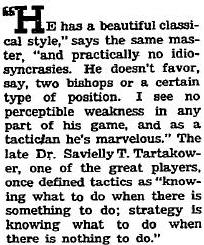
The article was reproduced on pages 49-55 of The Joys of Chess by Fred Reinfeld (New York, 1961), still with the initial T. for Tartakower’s second forename. Schonberg also ascribed the quote to Tartakower on page 160 of Grandmasters of Chess (Philadelphia and New York, 1972), and it is regularly seen in chess books, without a source. For instance, Gary Lane used it to fill a corner on page 57 of Prepare to Attack (London, 2010).
In his entry on aphorisms on page 16 of The Encyclopedia of Chess by Harry Golombek (London, 1977) Wolfgang Heidenfeld included the following:
‘“Whereas the tactician knows what to do when there is something to do, it requires the strategist to know what to do when there is nothing to do” (Abrahams).’
Heidenfeld gave no source, but we have found the remark on page 150 of Abrahams’ book Teach Yourself Chess (London, 1948), although with ‘strategian’ instead of ‘strategist’.
Furthermore, the following can be quoted from page 152 of The Handbook of Chess by Gerald Abrahams (London, 1965):
‘At many stages of the game the general choice is available; what to do now that there is no coercion? Epigrammatically, it may be said: Tactics are what you do when there is something to do. Strategy is what you do when there is nothing to do. That isolation, however, is rare. Strategy is a feature, albeit unobserved, of most good tactical play. It is latent – not patent.’
(8833)
From the ‘About the author’ page at the end of Kasparov’s Winter is Coming:
‘His 2007 book, How Life Imitates Chess, has been published in 26 languages.’
Has any other chess, or chess-related, book been translated so many times? We should like to receive (or, à défaut, to compile) a list of the 26 languages, and to know which of the translations have corrected the various errors in the original English edition. An example mentioned by us (see above) concerns the spurious Spielmann quotation.
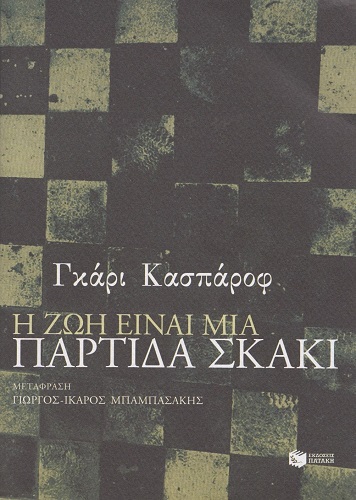
(9546)
To the Chess Notes main page.
To the Archives for other feature articles.
Copyright: Edward Winter. All rights reserved.